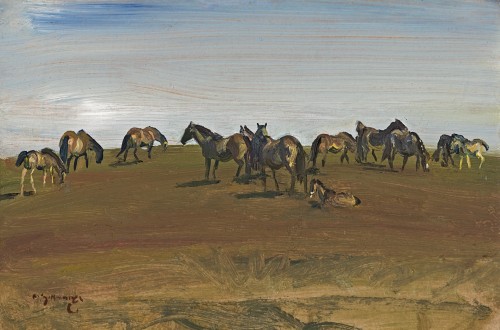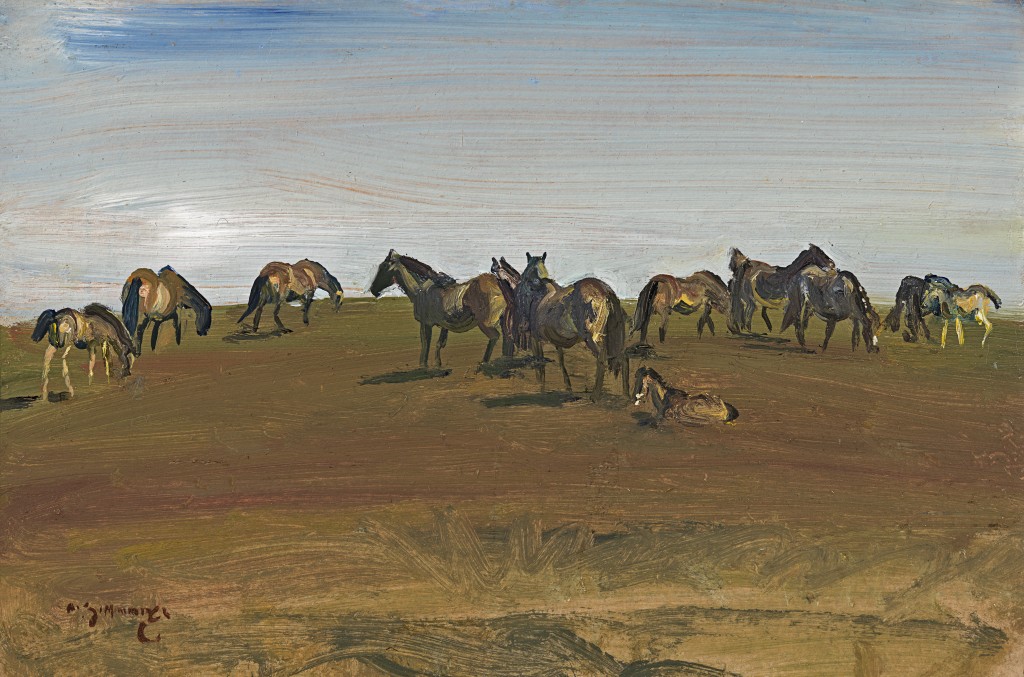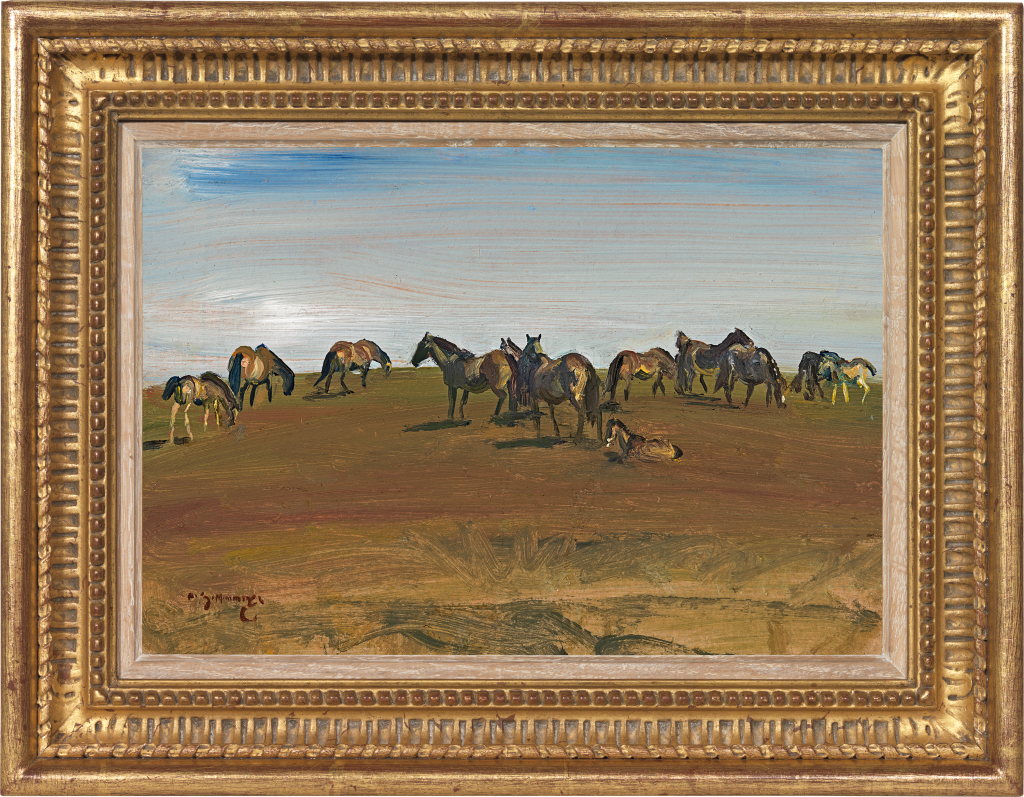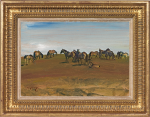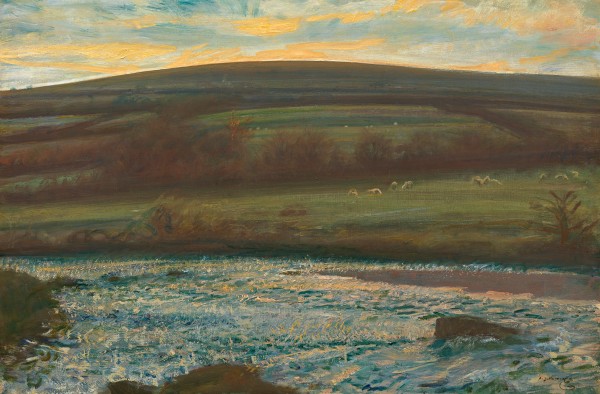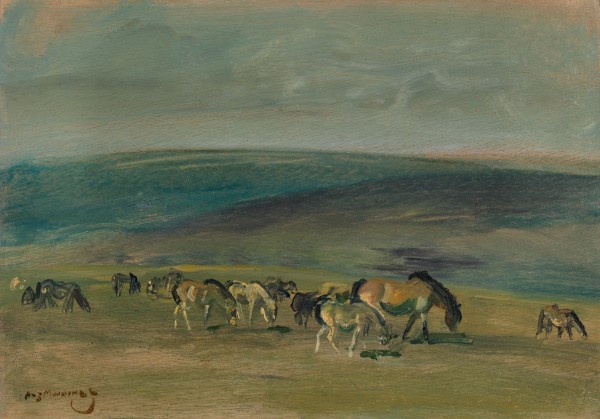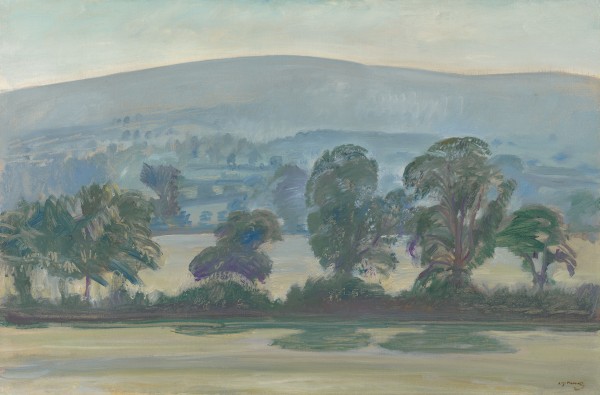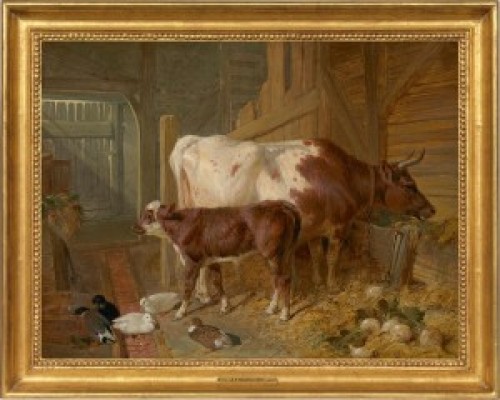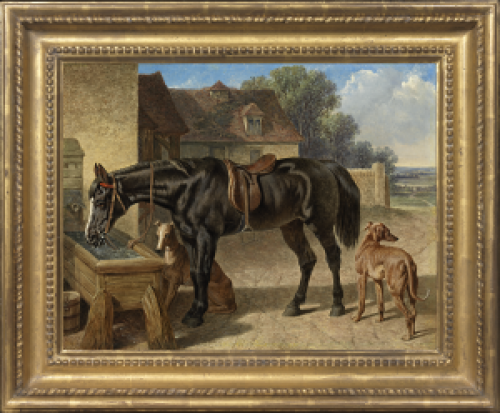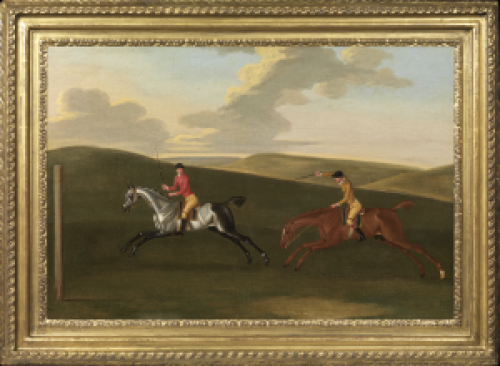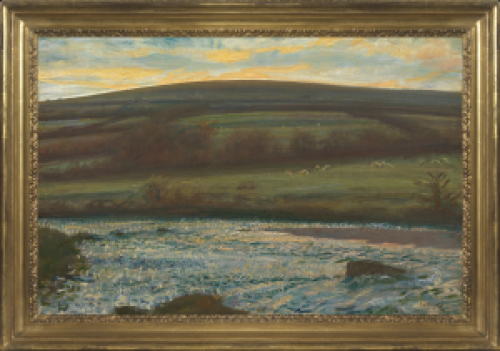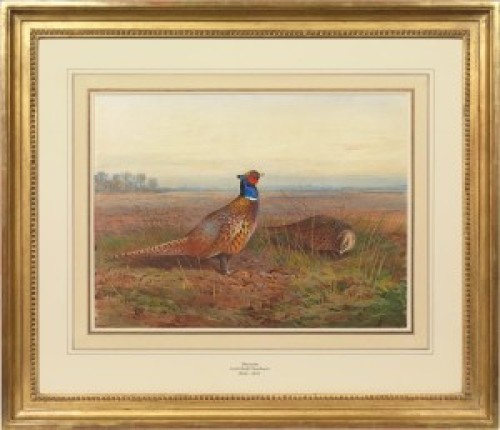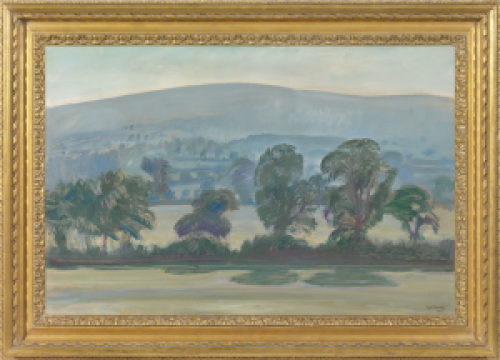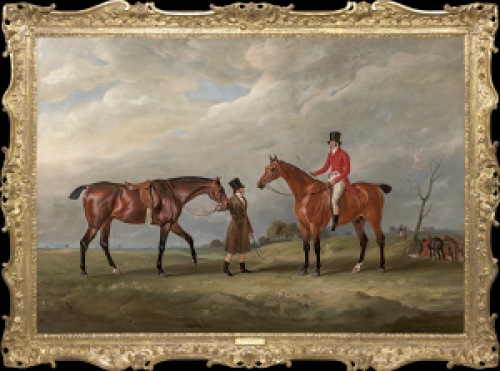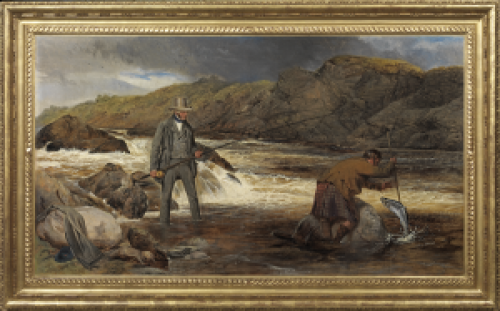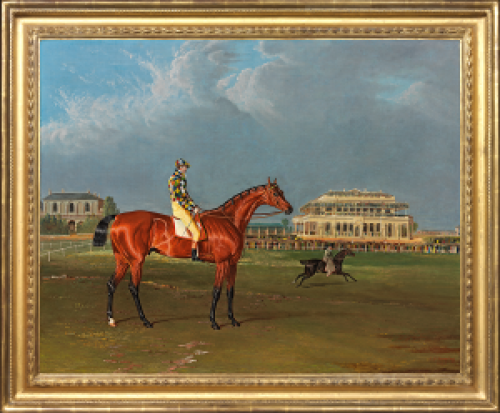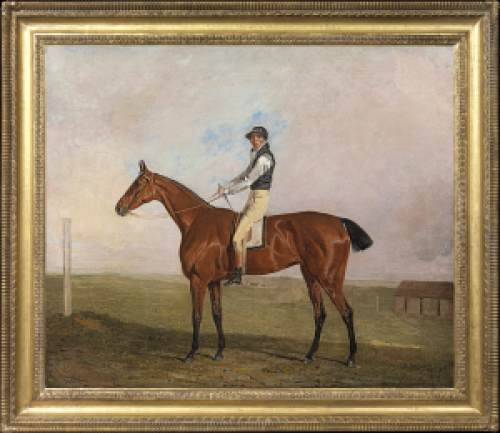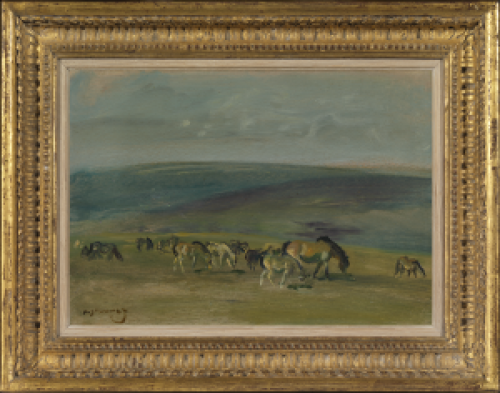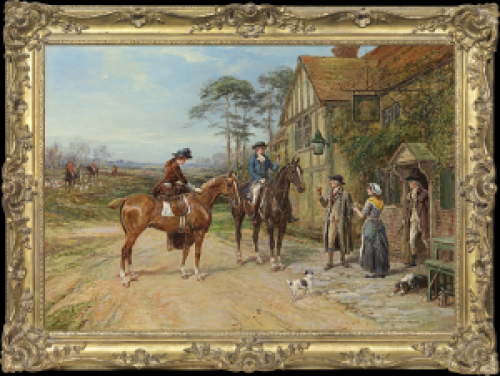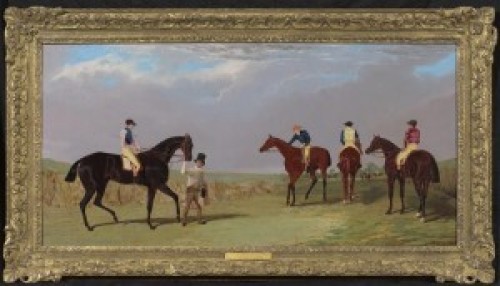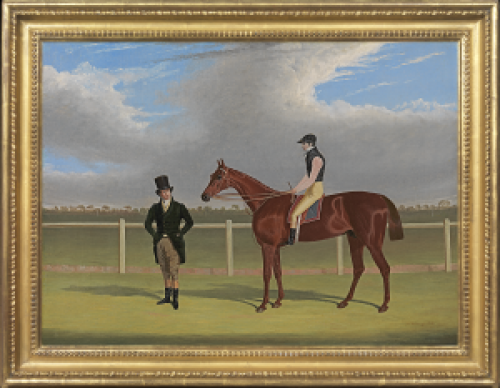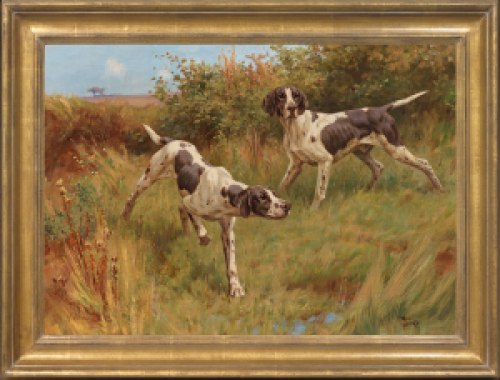SIR ALFRED MUNNINGS
Mendham 1878 - 1959 Dedham
Ref: CC 201
Exmoor ponies, study no.17
Signed lower left: A.J.Munnings
Oil on panel: 7 x 10 in / 17.8 x 25.4 cm
Frame size: 10 x 13 in / 25.4 x 33 cm
In an eighteenth century style carved and gilded fluted frame
Painted circa 1940
Provenance:
Ernest Brown and Phillips Ltd., The Leicester Galleries;
by whom sold for £42 to Mrs Maurice Holder, Triscombe Farm, Wheddon Cross, Minehead, Somerset
Gorringes, Lewes, March 2005;
private collection, UK
Literature:
Sir Alfred Munnings, The Finish, London 1952, illus. opposite p.112
Alfred Munnings’s second wife, the brilliant equestrienne Violet McBride, owned a hunting box at Withypool in Somerset from the 1920s. For Munnings, increasingly in demand as a Society equestrian portraitist and racing painter, visits to the West Country were a blessed escape, where he could indulge his delight in landscape and the animals which wandered freely over the moorland. Munnings wrote: ‘Ponies on the moor – I always wanted to paint them. Wild ponies wandering free over thousands of acres of wide, undulating expanse….Imagine an April day; the moors a patterned harmony of buff and brown….A stationary group of ponies against the sky, others lower down the slope, their foals lying basking in the sun, whisking curly tails’[1].
The difficulty was to track down the ponies on the vast terrain. Munnings equipped himself with a ‘pony-painting outfit, a strong fishing-bag, bought from Mr. Burgess at South Molton’[2], containing ‘my pochard painting-box, a carrier in which I could slide six wet panels, a cardboard box filled with small paint-tubes, bottles of turps, oil and copal varnish’[3]. He would ride out with his groom Harry Bayfield until they found the herd, then sent Bayfield off with his own horse, to return at 5pm when the painting day was done. ‘Standing there alone, two or three suspicious mares would stare at me, ready to trot off, whilst I pretended to look the other way, and walked nearer to them backwards. Then, sitting down, getting my pochard palette set, with a small selection of colour, and brushes in hand, I would wait awhile. At last, the mothers, seeing I was harmless, resumed grazing, whilst I stood up, crept nearer and began to work….Some of those small sketches, done in an hour, had a completeness and look of truth about them that one would never attain on a larger size’[4].
Munnings and Violet spent the years of the Second World War in Withypool after the Army requisitioned their Castle House in Dedham, Essex. Although he went back and forth to London on Royal Academy and other business, the war ironically gave him the freedom to paint the animals and landscape that he loved, away from the tyranny of Society commissions. Exmoor ponies, study no.17 is probably a fruit of that time. The ponies stand friezelike against an open-ended vista of purple-brown moor and milky blue sky, completely relaxed, their coats reflecting the pale sunlight. Munnings paints with economy, with free yet controlled brushwork and his unerring eye for harmony of composition.
In 1944 he wrote a poem, An Exmoor Lane, observing the ponies. One verse in particular sums up the spirit of this painting:
‘They know no bounds, they wander where they will;
They graze beside the stream that babbles by;
When days are hot, they stand upon the hill –
A silhouetted group against the sky.’[5]
SIR ALFRED MUNNINGS, PRA, RWS
Mendham 1878 - 1959 Dedham
Born in Mendham, Suffolk, Alfred Munnings was the son of a miller. He was apprenticed to a firm of lithographers from 1893 to 1898 and studied at the Norwich School of Art and in Paris. There he was impressed with plein-air naturalism; this, together with his introduction to the racecourse in 1899, influenced the themes for which he became famous.
While in Mendham, Munnings painted many scenes of country life, particularly horse fairs. He went to Cornwall in 1911, and for many years was an important addition to the Newlyn School of artists. When the First World War broke out, Munnings enlisted, despite having the use of only one eye owing to an accident in 1899. He became an army horse trainer near Reading and later went to France as an official war artist, attached to the Canadian Cavalry Brigade.
The year 1919 was a major turning-point in all aspects of Munnings’s life; he painted his first racehorse, Pothlyn, the winner of the Grand National, and became an Associate of the Royal Academy. He met Violet McBride, whom he was to marry, and bought Castle House, Dedham, where the Munnings Memorial Trust maintains a permanent exhibition of his pictures. Munnings’s prolific career, spanning over sixty years, brought him honour, with election to the Presidency of the Royal Academy in 1944, a Knighthood in 1945, and a personal award from the Sovereign in 1947, when he was created Knight of the Royal Victorian Order.
[1] Sir Alfred Munnings, The Finish, London 1952, p.108.
[2] Op. cit., p.108.
[3] Ibid., p.109.
[4] Ibid., p.110.
[5] Ibid., p.112.

